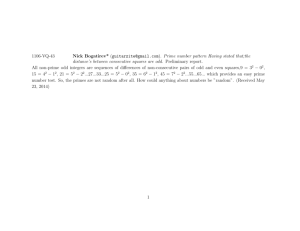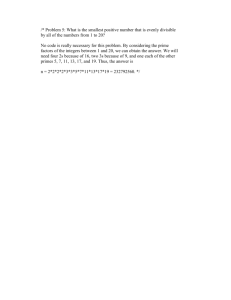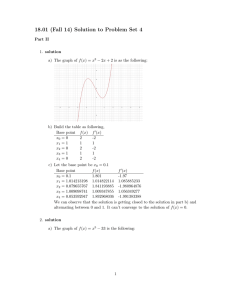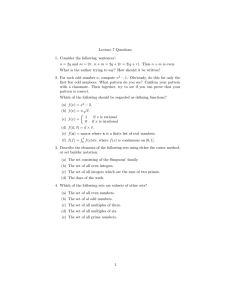ON DIVISIBILITY OF SOME POWER SUMS Tam´ as Lengyel
advertisement
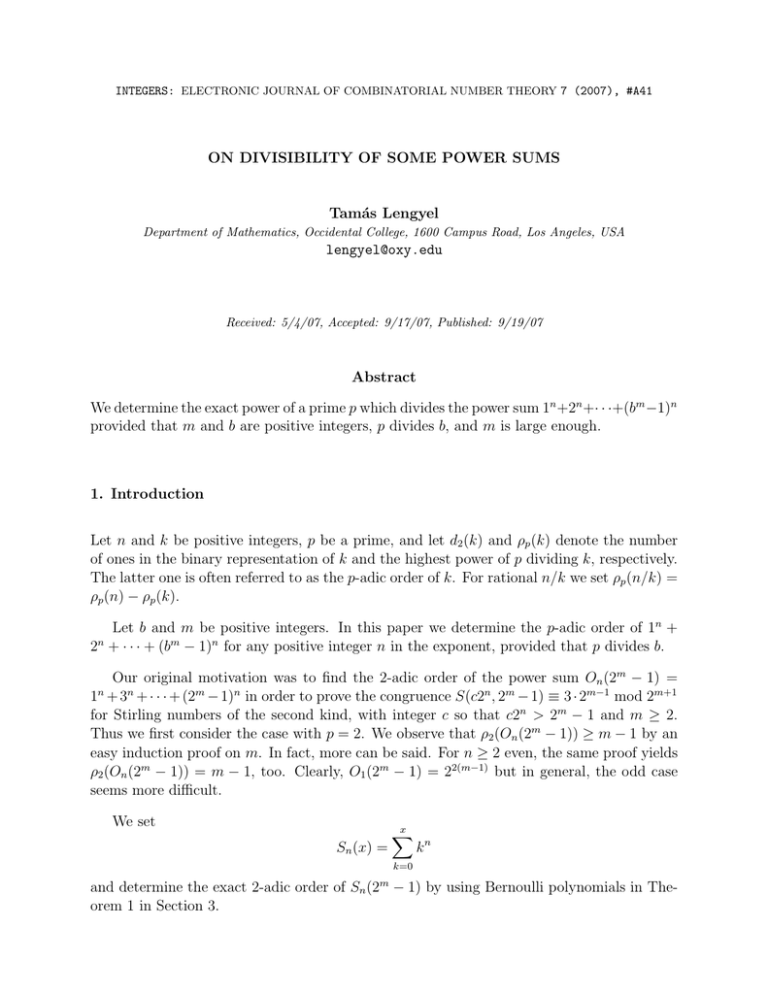
INTEGERS: ELECTRONIC JOURNAL OF COMBINATORIAL NUMBER THEORY 7 (2007), #A41 ON DIVISIBILITY OF SOME POWER SUMS Tamás Lengyel Department of Mathematics, Occidental College, 1600 Campus Road, Los Angeles, USA lengyel@oxy.edu Received: 5/4/07, Accepted: 9/17/07, Published: 9/19/07 Abstract We determine the exact power of a prime p which divides the power sum 1n +2n +· · ·+(bm −1)n provided that m and b are positive integers, p divides b, and m is large enough. 1. Introduction Let n and k be positive integers, p be a prime, and let d2 (k) and ρp (k) denote the number of ones in the binary representation of k and the highest power of p dividing k, respectively. The latter one is often referred to as the p-adic order of k. For rational n/k we set ρp (n/k) = ρp (n) − ρp (k). Let b and m be positive integers. In this paper we determine the p-adic order of 1n + 2n + · · · + (bm − 1)n for any positive integer n in the exponent, provided that p divides b. Our original motivation was to find the 2-adic order of the power sum On (2m − 1) = 1n + 3n + · · · + (2m − 1)n in order to prove the congruence S(c2n , 2m − 1) ≡ 3 · 2m−1 mod 2m+1 for Stirling numbers of the second kind, with integer c so that c2n > 2m − 1 and m ≥ 2. Thus we first consider the case with p = 2. We observe that ρ2 (On (2m − 1)) ≥ m − 1 by an easy induction proof on m. In fact, more can be said. For n ≥ 2 even, the same proof yields ρ2 (On (2m − 1)) = m − 1, too. Clearly, O1 (2m − 1) = 22(m−1) but in general, the odd case seems more difficult. We set Sn (x) = x ! kn k=0 m and determine the exact 2-adic order of Sn (2 − 1) by using Bernoulli polynomials in Theorem 1 in Section 3. INTEGERS: ELECTRONIC JOURNAL OF COMBINATORIAL NUMBER THEORY (2007), #A41 2 We generalize Theorem 1 and its proof in Theorem 3 in Section 4 for any prime p. We also obtain Theorem 4 in order to get a lower bound on the p-adic order of Sn (bm − 1) and Theorem 5 to determine the exact order for any large enough m. 2. An Odd Divisibility Property There is a general divisibility property that we can apply here to prove that S1 (bm − 1) | Sn (bm − 1) for n ≥ 1 odd. Of course, this already implies that ρp (Sn (bm − 1)) ≥ m. So, in general, we write Sn = Sn (c) where c is an arbitrary "c+1#odd positive integer. We can easily prove that Sn is divisible by S1 . Note that S1 = 2 . Then, by two different grouping of the terms in Sn we get $$ %n $ %n % c−1 c+1 n n n n c | (1 + (c − 1) ) + (2 + (c − 2) ) + · · · + + + cn , and 2 2 $$ %n $ %n % $ %n c+1 c−1 c+3 c+1 n n n n | (1 + c ) + (2 + (c − 1) ) + · · · + + + , 2 2 2 2 and the proof is complete since c and c + 1 are relatively prime. We note that Faulhaber had already known in 1631 (cf. [2]) that Sn (c) can be expressed as a polynomial in S1 (c) and S2 (c), although with fractional coefficients. In fact, Sn (c) can be " #2 written as a polynomial in c(c + 1) or c(c + 1) , if n is even or odd, respectively. This gives rise to the appearance of factors such as bm and b2m in Sn (bm − 1), depending on whether n is even or odd. 3. The Exact 2-adic Order Now we discuss the case with p = 2. Theorem 1 For m ≥ 1 and n ≥ 1, we have that & m − 1, if n is even or n = 1, ρ2 (Sn (2m − 1)) = 2(m − 1), if n ≥ 3 odd. We note that clearly, S1 (2m −1) = 2m−1 (2m −1). For m = 1, we have On (1) = Sn (1) = 1, and in general, for n ≥ 2, the 2-adic order of On (2m − 1) and Sn (2m − 1) are the same, as it easily follows from On (2m −1) = Sn (2m −1)−2n Sn (2m−1 −1); thus ρ2 (On (2m −1)) = ρ2 (Sn (2m −1)). INTEGERS: ELECTRONIC JOURNAL OF COMBINATORIAL NUMBER THEORY (2007), #A41 3 Proof of Theorem 1. The statement is true for n = 1 or m = 1 so we assume that n ≥ 2 and m ≥ 2 from now on. The Bernoulli polynomials [3] are defined by Bm (x) = m ! i=0 It is well known [1] that x ! k=0 kn = $ % i 1 ! k i (−1) (x + k)m . i + 1 k=0 k (1) Bn+1 (x + 1) − Bn+1 (0) . n+1 (2) The usual Bernoulli numbers can be defined as Bn = Bn (0), and the initial values are B0 = 1, B1 = −1/2, B2 = 1/6, B3 = 0, B4 = −1/30, B5 = 0, etc. Note that Bn =0 for every odd integer n ≥ 3. We form the difference in the numerator of (2) and then, for Bn+1 (x + 1), we use the binomial expansion of (x + 1 + k)n+1 and focus on terms with (x + 1)j with small exponents. We have ( $ % '! % n+1 i n+1 $ ! 1 ! i n + 1 Bn+1 (x + 1) − Bn+1 (0) = (−1)k (x + 1)j k n+1−j − k n+1 i + 1 k j i=0 j=0 k=0 $ %$ n+1 i ! 1 ! i = (−1)k (n + 1)(x + 1)k n i + 1 k=0 k i=0 $ % % % n+1 $ ! n+1 n+1 2 n−1 j n+1−j + (x + 1) k + (x + 1) k , 2 j j=3 so that $ %$ n+1 i ! Bn+1 (x + 1) − Bn+1 (0) 1 ! n k i = (−1) (x + 1)k n + (x + 1)2 k n−1 n+1 i + 1 k=0 k 2 i=0 "n# % n+1 ! j−1 j n+1−j + (x + 1) k . j j=3 Now we rewrite this with x = 2m − 1 and get that Sn (2m − 1) = n+1 ! i=0 "n# $ %$ % i n+1 ! 1 ! i n j−1 k m n 2m n−1 jm n+1−j (−1) 2 k + 2 k + 2 k . i + 1 k=0 k 2 j j=3 (3) If n ≥ 2 is even then we only need the first term in the last parenthetical expression, otherwise we need the first two terms. Let n ≥ 2 be even, then the term with j = 1 contributes m 2 n+1 ! i=0 $ % i n ! 1 ! 1 k i n m m (−1) k = 2 Bn (0) = 2 (−1)i i!S(n, i) i + 1 k=0 k i + 1 i=0 (4) INTEGERS: ELECTRONIC JOURNAL OF COMBINATORIAL NUMBER THEORY (2007), #A41 4 by identity (1), a standard formula for the Stirling numbers of the second kind, and S(n, n + 1) = 0. The other terms are all divisible by 2m . " i! # Clearly, ρ2 i+1 ≥ 0 if i ≥ 4. Indeed, in this case i − d2 (i) − ρ2 (i + 1) ≥ 0 since i ≥ 2$log2 (i + 1)%. Therefore, we need only the 2-adic order of 3 ! (−1)i 1 2 3 i!S(n, i) = − S(n, 1) + S(n, 2) − S(n, 3), i+1 2 3 2 i=0 ) * " m1 # m m 1 3n+1 +23 which yields ρ2 (Sn (2 − 1)) = ρ2 2 2 (3S(n, 3) + 7) = ρ2 2 2 2 = m − 1, by the identity S(n, 3) = 12 (3n−1 − 2n + 1), n ≥ 1. Note that ρ2 (Sn (2m − 1)) = ρ2 (2m Bn (0)) = m − 1 also follows by simply noting the well-known fact about the Bernoulli numbers that ρ2 (Bn (0)) = −1 for even n ≥ 2 by a theorem by von Staudt [5]. ! Theorem 2 (von Staudt, [5]) For n = 1 and n ≥ 2 even, we have −Bn ≡ ! 1 mod 1. p p prime p−1|n Proof. Clearly, for n even, the denominator of Bn is the product of the primes p with (p − 1) | n, and thus, it must be square-free. It follows that ρp (Bn ) ≥ −1 for all primes p, and it is nonnegative unless (p − 1) | n. Now assume that n ≥ 3 is odd. The first two terms in the parenthesis of (3) contribute "# n " # n−1 + +i +n+1 1 +i 1 k i 2m n k i 2m n+1 i=0 i+1 k=0 (−1) k k + 2 i=0 i+1 k=0 (−1) k k 2 + (−1)i m 2m−1 = 2m Bn + 22m n2 n+1 nBn−1 . i=0 i+1 i!S(n − 1, i) = 2 Bn + 2 The 2-adic order is 2(m − 1) since Bn = 0 and ρ2 (Bn−1 ) = −1 since n ≥ 3 is odd. The other terms of (3) with j ≥ 3 are all divisible by 22m since jm − ρ2 (j) > 2m for m ≥ 2, as j−2 > m1 in this case. ! log j 2 Remark 1. The above proof can be generalized to the case in which 2m is replaced by (2c)m with any odd integer c ≥ 1. 4. The General Case: The Exact p-adic Order n + (j−1 ) mj We note that Sn (2m − 1) = n+1 by (3) with an observation similar to (4), j=1 2 Bn+1−j j and in general, for any positive integer b, "n# n+1 ! j−1 Sn (bm − 1) = bmj Bn+1−j . (5) j j=1 We now prove the generalized version of Theorem 1. INTEGERS: ELECTRONIC JOURNAL OF COMBINATORIAL NUMBER THEORY (2007), #A41 Theorem 3 For m, n, and b positive integers with have that " if m + ρp (Bn ), m " ρp (Sn (b − 1)) = m + ρp (Bn ), if " 2m + ρp (Bn−1 ) + ρp (n/2), if 5 p | b, p prime, and m" = m ρp (b), we n = 1, n is even and ρp (Bn ) = 0 or − 1, n ≥ 3 odd and ρp (Bn−1 ) = 0 or − 1. (6) Proof. We have already proved the statement for p = 2 in Theorem 1 and Remark 1. If p ≥ 3 then the case with n = 1 is easy to check. Thus, we can also assume that n ≥ 2. We now prove the theorem with ρp (b) = 1, i.e., if m" = m. The general case with ρp (b) ≥ 1 easily follows by replacing m by m" in the proof below. First, if n is even then all terms with j ≥ 5 on the right hand side of (5) are divisible j−1 by pm+1 since jm − 1 − ρp (j) ≥ m + 1 as 2+log ≥ m1 for m ≥ 1. If j = 3 and p = 3 then pj 3m + ρ3 (Bn−2 ) − ρ3 (3) ≥ m + ρ3 (Bn ) + 1 for m ≥ 1 and n ≥ 2 even. If j = 3 and p ≥ 5 then clearly 3m − 1 − ρp (3) ≥ m + 1. The term with j = 2 works since Bn−1 = 0 except for n = 2 when 2m − ρp (2) ≥ m + 1. The term with j = 4 also works for n ≥ 4 since Bn−3 = 0 except for n = 4 when 4m − ρp (4) ≥ m + 1. Next, if n is odd then we have two cases. Case 1. If n = 3 then for j = 3 and 4 we have either p = 3 and thus, jm + ρ3 (B4−j ) − 1 ≥ 2m + ρ3 (B2 ) + 1, i.e., jm − 1 ≥ 2m for m ≥ 1; or p ≥ 5 and thus, jm + ρp (B4−j ) ≥ 2m + ρp (B2 ) + 1, i.e., jm ≥ 2m + 1 again. "n# " # n n−1 Case 2. If n ≥ 5 odd then we rewrite j−1 as j−1 for j ≥ 2. All terms with j ≥ 5 on j−2 2m+ρp (n/2)+1 the right hand side of (5) are divisible by p since jm − 1 + ρp (n) − ρp (j(j − 1)) ≥ 1 2m + ρp (n/2) + 1 as 2+ρpj−2 ≥ for m ≥ 1. If p = 3 then for the term with j = 4, we (j(j−1)) m get that 4m + ρ3 (Bn−3 ) + ρ3 (n) − ρ3 (4 · 3) ≥ 2m + ρ3 (Bn−1 ) + ρ3 (n/2) + 1 since 4m − 2 ≥ 2m for m ≥ 1 and ρ3 (Bk ) = −1 for k ≥ 2 even. If p ≥ 5 then for the term with j = 4, we get that 4m − 1 + ρp (n) ≥ 2m + ρp (n/2) + 1 since 4m − 1 ≥ 2m + 1 for m ≥ 1. The term with j = 3 makes no contribution to (5) as Bn−2 = 0. ! We obtain a lower bound and the exact p-adic order of Sn (bm − 1) in the next two theorems. Theorem 4 For m, n, and b positive integers with p | b, p prime, and m" = m ρp (b), we have that & m" − 1, if n is even or n = 1, ρp (Sn (bm − 1)) ≥ 2m" + ρp (n/2) − 1, if n ≥ 3 odd. INTEGERS: ELECTRONIC JOURNAL OF COMBINATORIAL NUMBER THEORY (2007), #A41 6 Theorem 5 For m, n, and b positive integers so that m is sufficiently large and p | b, p prime, and m" = m ρp (b), we have that & m" + ρp (Bn ), if n is even or n = 1, ρp (Sn (bm − 1)) = " 2m + ρp (Bn−1 ) + ρp (n/2), if n ≥ 3 odd. The proof of Theorem 3 shows how to extend it to those of Theorems 4 and 5. A result by Andrews [6] implies that ρp (Bn ) can be arbitrary large. For example, if (p − 1) ! n and ρp (n) = l > 0 then ρp (Bn ) ≥ l, and this suggests that it might be difficult to get the exact order of ρp (Sn (bm − 1)) with a formula, similar to (6), which is uniformly valid in all m. Remark 2. We intended to find the p-adic order of Sn (x) for special integers of the form x = bm − 1 with p | b, however, the above theorems remain true for x = c bm − 1 with p | b and p ! c, by adjusting identity (5). In this case, Sn (c bm + 1) ≡ 1 mod p also follows if m is sufficiently large. "n# We note that if p divides b for some prime p, and we calculate Bn+1−j j−1 /j in (5) padically, such as by using a theorem discovered independently by Anton, Stickelberger, and Hensel [4] on binomial coefficients modulo powers of p, then we can find further and more refined congruential properties of Sn (bm − 1). Acknowledgment The author wishes to thank Gregory Tollisen for making helpful suggestions and comments that improved the presentation of this paper. References [1] L. Comtet, Advanced Combinatorics, D. Reidel Publishing Co., Dordrecht, 1974. [2] A. W. F. Edwards, A quick route to sums of powers, Amer. Math. Monthly, 93(6):451–455, 1986. [3] R. L. Graham, D. E. Knuth, and O. Patashnik, Concrete Mathematics, Addison-Wesley Publishing Company, Reading, MA, second edition, 1994. [4] A. Granville, Arithmetic properties of binomial coefficients I, Binomial coefficients modulo prime powers, In Organic Mathematics (Burnaby, BC, 1995), volume 20 of CMS Conf. Proc., pages 253–276. Amer. Math. Soc., Providence, RI, 1997. Electronic version (a dynamic survey): http://www.dms.umontreal.ca/∼ andrew/Binomial/. [5] G. H. Hardy and E. M. Wright, An Introduction to the Theory of Numbers, The Clarendon Press Oxford University Press, New York, fifth edition, 1979. [6] R. Thangadurai, Adams theorem on Bernoulli numbers revisited, J. Number Theory, 106(1):169–177, 2004.
